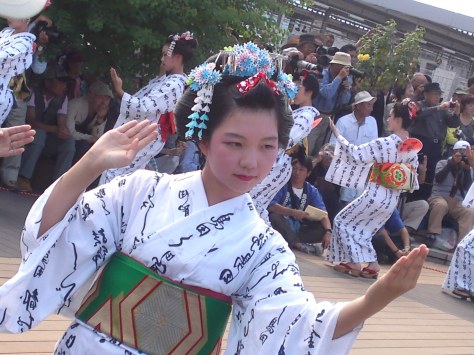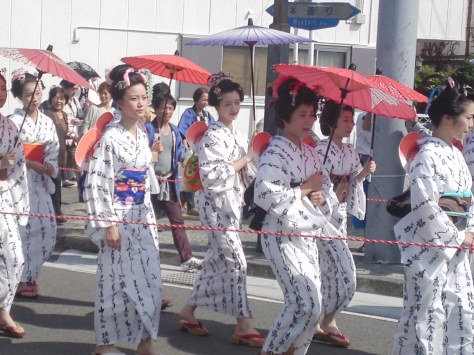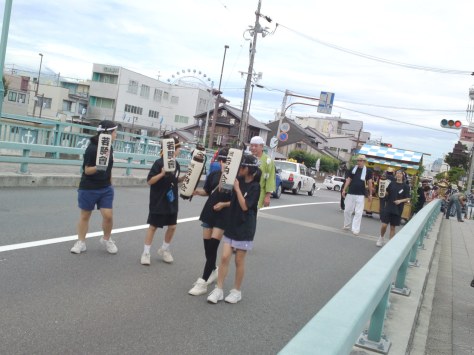The Shimada Oo Matsuri-島田大祭, also called Shimada Obi Matsuri-島田帯祭, is a rare Festival as it is held only every three years, therefore 2016 will be most important for Festivals in Shimada City when all three big Festivals will be held, an occurrence one can enjoy only every 6 years!
Thanks to the Daimyou Gyouretsu/大名行列/Lord Parade featuring the sash saber dancers, it has been officially named one of the so-called three most unusual festivals in Japan!
It will be held in 2016 on Saturday, October 8th, Sunday October 9th and Monday October 10th (the latter being a national Holiday)!
This also becomes an incredible chance for photographers who will not have enough of the three days that the Festival lasts!
Let me at least give them an introductory guide to expand at will for superb photography!
“Happi/半被” or Festival Coats!
“Happi/半被” could be translated as half coats and which are usually worn at Festivals or special occasions to show to which group you belong!
But there are also purely artistic Happi!

A classical design with a lion!

Another classical happi with a prawn motif at the top!

A more artistic happi with a stylized Kabuki Theater Face Painting!

Samurai Fight!

The broken mask of a Goblin/Oni called “Han Ya” in Noh Theater!

River-crossing Lady! That is the very Ooi River in Shimada City!

A Phoenix, a Winged Horse/Pegasus and a Turtle in front of a red Mount Fuji!
Faces of Men!

Behave yourself at Festival or I’ll get at you!
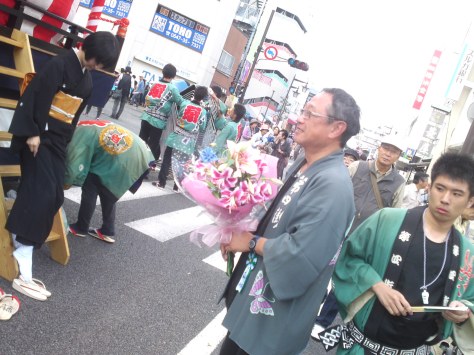
My good friend Hisatsugu Umehara/梅原詞さん who has been helping the fourth district (there are no less than 7 organizing the whole festival!) for the 7th time in a row! (Multiply by 3=18 years!)

Don’t touch the sake without my permission!

One cup of sake per person only! Understood?

Easy hairstyles?

This chap would have been a hit with Medieval European ladies!

When you grow older, whiter and less abundant, sport a beard!

11 am and already happily drinking!
Great smiles!
Faces of Ladies!

The cutest ladies at the festival? Definitely the most serious about it!

Flaming hair!

These two ladies selling at a food stand were certainly having a good time!
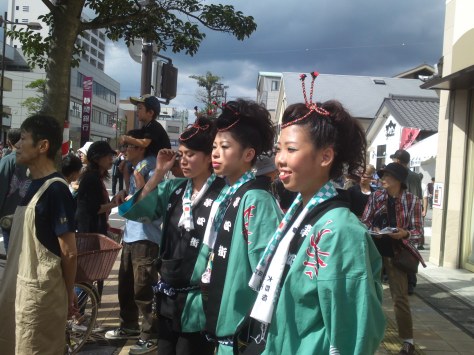
The color of their hair is a sign of their seriousness!

We’ll see many more of these with such grand hairstyles!
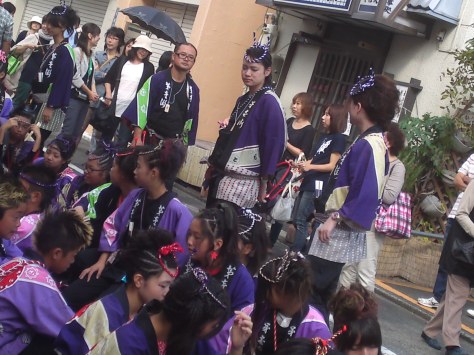
Looking after the younger generation.

My favorite picture!

Tigerish hairstyle?

I’m so bleeding tired…..
The Kids!

The best picture of the day!

Teaching by example?

So well-behaved!

Aren’t we beautiful?

These are tough kids who had to walk no less than 1.7 km a day for 3 days in a row!
Also very tough for the parents who walked behind in holiday finery!

Note the mothers following their kids in 30 degrees Celsius heat!

Horse Lord !

Horse Lord !

The festival chariots also served as dancing stages where incredibly clad kids form 4 to 9 years old performed traditional Japanese dances to the sound of instruments and singers’ voices!

The dancers had to be carried on a strong man’s back up onto and down form the stages!
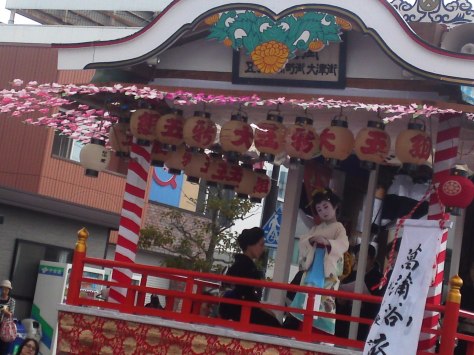
Dancing genius!
The Food Stands!

Brochettes, brochettes, brochettes!
At any Festival worth its salt the Japanese take for granted what becomes nothing less than a giant BBQ!

Charcoal-grilled “ayame” trouts!

Naturally, sausages are a must!

It is also a good time to sample specialties from all over Japan: Oita (Kyushu) style stir-fried chicken!

Hiroshima-style noodles, pasta, Yaki, Okonmiyaki!

Yakitori!
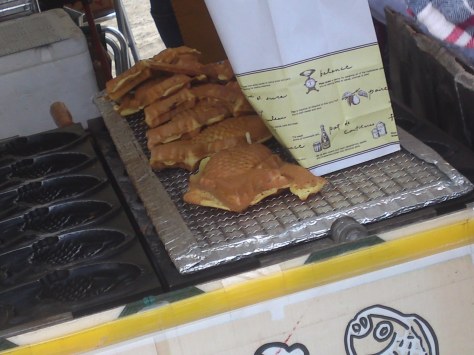
Tai Yaki (seabream-shaped pancakes containing anko/sweet meat beans) for the kids and sweet teeth!

Spicy stir-fried chicken!
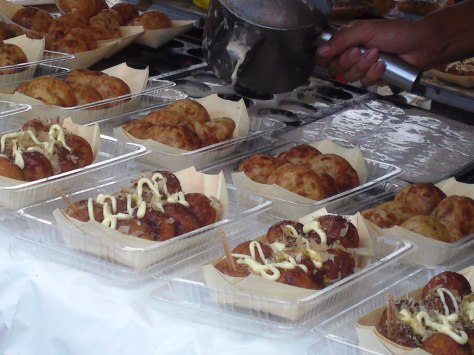
Osaka-style takoyaki/dumplings containing octopus!
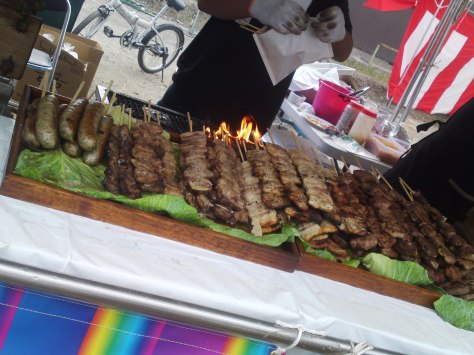
These particular charcoal-grilled sausages and pork brochetttes stand had a constant 20-people queue stretching in front of it!

Oden! A shizuoka specialty!

Kawane green tea!
Shizuoka produces more than 45% of all green tea in Japan!
The “Clash” of the Chariots!

Make way!
Do come early in the day to watch the clash of the chariots (not real floats) and all its fun!

Dai Nikai Yatai/Second district Chariot
The Chariots/Yatai seen during the Shimada Obi Festival are chariots more than floats.
Shimada City counts seven districts, Dai/第 Ichi, Ni, san, Yon, Go, Roku and Nana Kai/街.
The first six districts look after their own chariot which is also used as theater platform where plays are enacted by local kids.
The seventh district is in charge of the Lord Parade/Daimyou Gyooretsu!

The “movers”!
Although the chariots are mounted on wheels, these same wheels are more of wood and metal and are fixed to the frame. They do not roll!
One main reason for that is that a free-wheeling chariot is just too unstable to control.
Hence the armies of “movers”!

Now, this is tough work to ensure three days in a row!
Each “mover” is armed with a long pole made of a solid tree trunk cut at a slant at its base.
The poles will be used to lift and push the chariots from any side as thick tree trunks are fixed to the bottom frame just above ground!

Whereas at other times of the day the chariots will become the theater stages, in the morning they are paraded along the main street to the sounds of drum and Japanese fife players sitting inside!

The rope pullers of the Dai Ni Kai!
On the other hand teams of young men will pull the chariots with long ropes to help move forward.
But when it comes to moving sideways the “movers” will take care of the show!

The “cheerleaders” standing on the roof, sticks in hands!
Notice that they are all light-weight!

Start the drums!

The “clash” is beginning!
Actually it is all carefully planned banter.
The two chariots “riders” will scream at each other to leave the way or move aside.
There will be no real fight in spite of the very “serious” faces of the participants.
But in the rare occasion when the chariots do hit each other by accident older members will immediately run between the handlers and shout them away from each other in no uncertain words!
The police is invisible at such times and the citizens handle themselves!

The “riders” guiding the “pullers” and Movers” sideways to the sounds of sticks and whistles!

C’mon guys! Let’s go with it!

Move aside, will ya!

It is the turn of the riders to frantically scream at each other while directing their respective chariots!

Very little leeway, I can assure you!

All the time the fans’ fans in a frenzy!

Safely through, but look at those “stares”!
Daimyou Gyouretsu-The Lord Parade!

The Sabres Dancer!
The finale of the day(s)!

The Daimyou Gyouretsu/大名行列 is the sole responsibility of the Dai Nana Kai/第七街/Seventh District and comes last after all the chariots, stage dancers and parades have come through since 8:30 a.m. They usually start between 13:00 and 14:30 depending on the day.
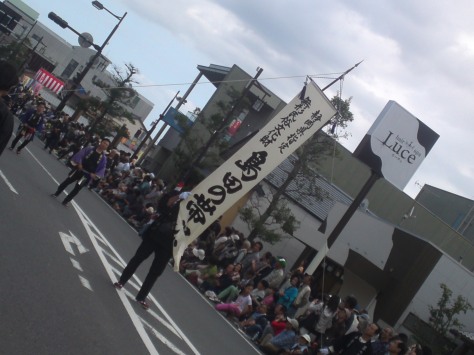
They are very strict about the organisation and young members ensure that there isn’t the slightest impediment.

The “leaders” are extremely proud of their prerogatives, even by Japanese standards.
This is after all the aristocratic part of the festival and in Edo times they were far more obvious about their power and authority as the local Lord and his retainers paraded for real!

The lancers!

The Lord’s mark of authority carried inside portable boxes! Heavy stuff actually!
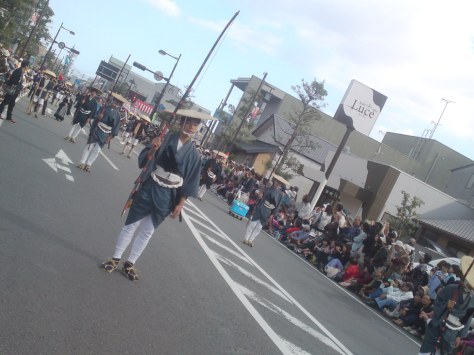
The archers!

Kids have also taken the place of the Lord and his sons on horses!
And horse handlers are now ladies!

At least these kids are not taking it all too seriously!
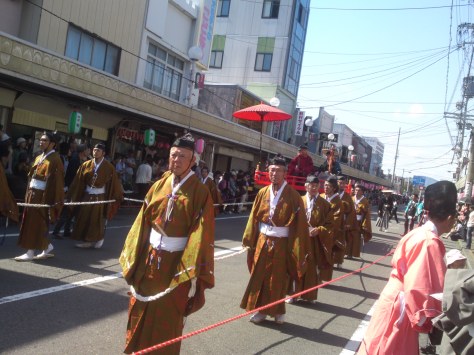
The Overlord was pulled along atop a small float.

Bow to the Lord!

At last the ones all had been waiting!
The Sabre dancers!
This very feature gives the unique name and fame of this festival in the whole of Japan!
Enormous obi/sashes are wrapped around giant swords secured by sashes around the dancers’ waists.

All the dancers carry different obi/sashes wrapped around their swords.
The “apron” is also unique.
All are made of expensive silk. They carry a real fortune along which is is displayed only for three days every three years!
The Parade is a very expensive a affair to take charge of. Therefore it has been held every 3 years only for 107 times!
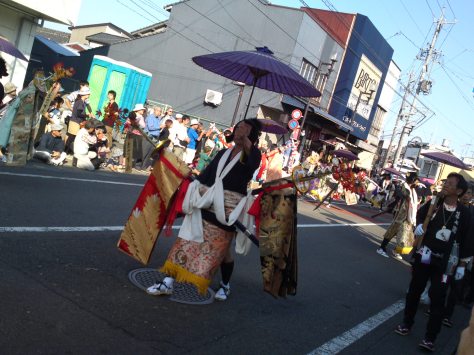
The dancing is also a tough challenge along the 1.7 km ( 1 mile) main road which takes more than two hours.
To think they go through that three days in a row!

The Dancers have to hold an umbrella (they certainly need it in the heat!) with one hand, make big waves with the other hand and raised the knees high with every step!

Tough work to raise your knees under that heavy apron!

Tough work too to raise your arm above the shoulder and make a circling wave back and forward!
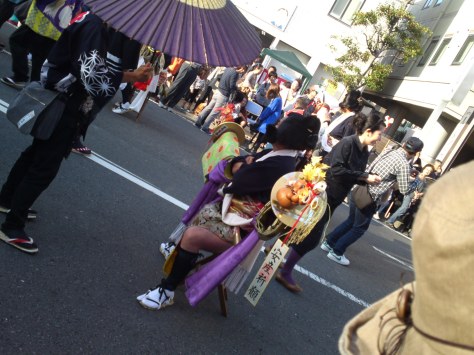
A well-earned rest!
Mind you, even in such a sitting position it must be tough to carry all that finery along!

Fortunately an army of handlers is there to give plenty of support, water and encouragements!

One thing was sure, all had strong legs!
The dancers are basically different every three years as it is a very sought after honor!

This particular dancer was very popular with the crowd as he took often the time to look and wink at them. Note the whiskers!

A common feature to top-class Japanese Festivals, the “matoi” or firemen festival pole!
Waiting for you!
RECOMMENDED RELATED WEBSITES
So Good Sushi Restaurant in Nice France
Navigating Nagoya by Paige, Shop with Intent by Debbie, BULA KANA in Fiji, Kraemer’s Culinary blog by Frank Kraemer in New York,Tokyo Food File by Robbie Swinnerton, Green Tea Club by Satoshi Nihonyanagi in Shizuoka!, Mind Some by Tina in Taiwan, Le Manger by Camille Oger (French), The Indian Tourist, Masala Herb by Helene Dsouza in Goa, India, Mummy I Can Cook! by Shu Han in London, Pie
rre.Cuisine, Francescannotwrite, My White Kitchen, Foodhoe, Chucks Eats, Things that Fizz & Stuff, Five Euro Food by Charles,Red Shallot Kitchen by Priscilla,With a Glass, Nami | Just One Cookbook, Peach Farm Studio, Clumsyfingers by Xethia, PepperBento, Hapabento, Kitchen Cow, Lunch In A Box, Susan at Arkonlite, Vegan Lunch Box; Tokyo Tom Baker, Daily Food Porn/Osaka, Only Nature Food Porn, Happy Little Bento, J-Mama’s Kitchen, Cook, Eat, Play, Repeat, Bento Lunch Blog (German), Adventures In Bento, Anna The Red’s Bento Factory, Ohayo Bento,
Must-see tasting websites:
-Sake: Ichi For The Michi by Rebekah Wilson-Lye in Tokyo, Tokyo Through The Drinking Glass, Tokyo Foodcast, Urban Sake, Sake World
-Wine: Palate To Pen, Warren Bobrow, Cellar Tours, Ancient Fire Wines Blog
-Beer: Another Pint, Please!, Beering In Good Mind: All about Craft Beer in Kansai by Nevitt Reagan!
ABRACADABREW, Magical Craftbeer from Japan
-Whisky: Nonjatta: All about whisky in Japan by Stefan Van Eycken
-Japanese Pottery to enjoy your favourite drinks: Yellin Yakimono Gallery
Non gastronomy must-see sites by Shizuoka Residents
HIGHOCTANE/HAIOKU by Nick Itoh in Shizuoka City






























































































































































































